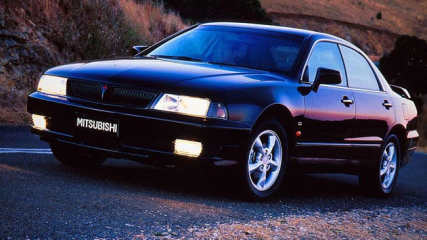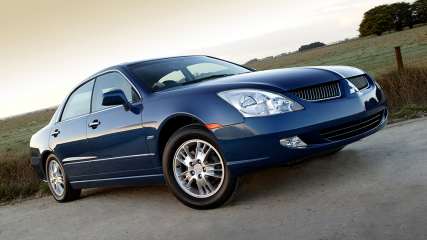2003 Mitsubishi Verada Reviews
You'll find all our 2003 Mitsubishi Verada reviews right here. 2003 Mitsubishi Verada prices range from $3,960 for the Verada Awd to $7,040 for the Verada Ei.
Our reviews offer detailed analysis of the 's features, design, practicality, fuel consumption, engine and transmission, safety, ownership and what it's like to drive.
The most recent reviews sit up the top of the page, but if you're looking for an older model year or shopping for a used car, scroll down to find Mitsubishi dating back as far as 1991.
Or, if you just want to read the latest news about the Mitsubishi Verada, you'll find it all here.

Used Mitsubishi Magna and Verada review: 1991-2005
Read the article
By Ewan Kennedy · 28 Sep 2012
These big Mitsubishi family cars have a well-deserved reputation for being smooth and refined and in its early days the Magna made Holden’s Commodore and Ford’s Falcon rather ordinary in the noise, vibration and harshness (NVH) stakes.Mitsubishi Verada was the name given to upmarket versions of the Magna and is sometimes regarded as a different model, though in reality, it’s just a Magna with plenty of extra kit stuffed inside.All were built in Adelaide. The first Magnas were very much Australian products, later they became more closely allied to Japanese Mitsubishi models. The Mitsubishi 380 was based on an American Mitsubishi model and was larger and plusher than the Magna.This once successful line of cars came to an abrupt end in April 2008 after slow sales of the 380 caused Mitsubishi to pull out of Australian manufacturing. In hindsight if the company had simply called the 380 the next generation Magna, the Adelaide factory might still be in operation today.Body types are four-door sedan and five-door station wagon in the Magna/Verada, but the 380 was only built as a sedan. Rear-seat width isn't quite as good as that in Commodore and Falcon, but the Mitsubishi’s seats can handle three adults in reasonable comfort.The big Mitsubishis have reasonably good handling for family cars, with the 380 feeling nice and sharp on the road. Engine performance from the old-style four-cylinder 2.6-litre engine is reasonable, but only just. The later four-cylinder models had a 2.4-litre unit with a much-improved design.Four-cylinder models slowly declined in popularity over the years and were finally removed from the Magna range in 1999. Those on the used-car market now are likely to be near the end of their lives, though it must be said they are tough old units. A 3.0-litre V6 engine was released in the Mitsubishi Verada in 1991 and the Magna in 1993.It was joined by a 3.5-litre V6 in some upmarket variants in October 1996. The bigger engine gradually spread to the rest of the range. In the later-model Magna Sports and VR-X, the 3.5 engine has additional power over the standard unit. The Mitsubishi 380’s 3.8-litre engine is a stretched version of the 3.5-litre unit.There is good torque throughout the normally used zone of the rev range and the 3.8 is very pleasant to sit behind. Magna is offered with a five-speed manual gearbox, but the great majority of the original cars came with a four-speed automatic. A sequential shifting was first fitted on four-speed Magna Sports models from September 1997.An advanced five-speed automatic transmission with a sequential shifter is fitted to the sporty variants sold from August 2000 and made its way to the other models over the next couple of years. Mitsubishi 380 came with a five-speed automatic transmission or a five-speed manual gearbox.The auto was by far the most popular and the manual could be a problem to resell in years to come as the number of drivers interested in doing their own gear changes continues to decline. Mitsubishi’s Magna offers the extra traction of all-wheel drive in some sports variants to give the car a real sporty feeling.These all-wheel drives are a real pleasure to punt hard and fast and keen drivers love their feel and grip. But they were never popular and could be hard to resell. These big Mitsubishis are spacious in their under bonnet area so servicing is relatively easy for amateur mechanics to carry out. Make sure to get a professional mechanic for safety-related work. Mitsubishi continues to operate strongly in Australia despite no longer being a local manufacturer. Spare parts for cars up to 10 years old are still carried by Mitsubishi dealers. Prices are generally reasonable and we seldom hear of any real availability problems. Insurance charges are usually moderate and most companies charge much the same for four and six-cylinder engines. There may be an increase in the premiums for the Sports model if the driver is young and/or inexperienced.WHAT TO LOOK FORRust is seldom a problem but in a few cars it gets into the bottom edges of the doors, boot lid and or tailgate, and the fuel filler flap. Look for signs of damage to seats, carpets and trim, including inside the boot. Examine the top of the dash panel and the rear parcel shelf for faded, or cracked, plastic caused by constant exposure to sunlight. Automatic transmission problems have dogged these Mitsubishis but troubles are less frequent in newer models than in older ones. Watch for an automatic that shifts gear when it doesn’t need to or suddenly shifts into neutral of its own accord. Look at and feel the front tyres for uneven wear, which can indicate front suspension problems. Check the paint and bumper bar around the exhaust tailpipe for an oily film, indicating engine problems. Make sure the brakes pull the car up in a straight line and that ABS, if fitted, sends a pulsing back through the pedal on hard application. Don’t forget to check your mirrors first!CAR BUYING TIPWhen checking out a car aimed at the family buyer make sure to spend plenty of time looking over the back seat and the luggage area.

Mitsubishi Verada 2003 Review
Read the article
By CarsGuide team · 20 Jun 2003
They claim the emotive benefits of all-wheel drive include dynamic handling, the pleasure of driving, image, superiority, exclusivity and individuality. The rational benefits they attribute to it include greater traction, safety, ground clearance, robustness, towing reliability and stability.The results of the survey, conducted by Austrian all-wheel-drive component maker Magna Steyr, were announced at the 4th International All-Wheel-Drive Congress in Graz, Austria, in February.Coincidentally, Mitsubishi released its all-wheel-drive Magna and Verada models about the same time, but the pre-launch demand hasn't exactly translated into big sales. In fact, a lot of things could have been done better in launching Australia's first home-grown all-wheel-drive sedan, which has beaten Holden and Ford to the top of the all-wheel-drive podium here.That's a shame because the Magna all-wheel drive is one of the sweetest-handling, most functional sedans on the Australian market – even more important given it has been designed and built here.Compared with the standard front-drive Magna, the all-wheel drive is flatter through the curves and shows less nosedive on braking, with minimal rear-end squat on acceleration.These traits extend to improved general handling, enhancing the confidence of the Magna through tight bends while minimising the front-drive version's slight tendency to understeer.In saying all this, the front-drive model is as good as most drivers will want. For such owners, understeer is about as tangible as the tooth fairy. For you guys, the standard Magna Sports ($39,590) is an excellent car and the extra $3700 for an all-wheel drive is probably best spent on three years of fuel.However, for those who enjoy a brisk drive and understand the safety advantages, there is the comfort of knowing that this is the most affordable mid-size all-wheel-drive sedan on the market. It's also a great drive.Mechanically, the Magna/Verada all-wheel drive uses some oily bits from the Japan-only Diamante all-wheel drive and also includes a few from the Lancer Evo VI, and together it's called QuadTec.All this is powered by one of my favourite V6s, the 3.5-litre that goes to 180kW and later this year will stretch to 200kW – all on standard unleaded petrol.The Sports all-wheel drive gets a healthy 159kW – up 5kW from the standard model though arriving 500rpm later at 5500rpm – and serious torque of 318Nm at a surprisingly brisk 4000rpm.Mitsubishi sells its all-wheel-drive sedan range in three models – Magna all-wheel drive, Sports all-wheel drive (as tested) and Verada all-wheel drive– and all come only with a five-speed Tiptronic box.Standard on the Magna Sports all-wheel drive are sports suspension and brakes, climatic airconditioning, electric windows and mirrors, dual airbags and 215/60R16 Bridgestone tyres on seven-spoke 16-inch alloys.I appreciate the way this car works – seating five adults and having a huge boot – and can complain only about the depressing black-on-black dashboard and ageing body shape. Let's hope such grumbles will vanish next month with the new Magna – and that all-wheel drive continues as an option.




